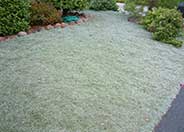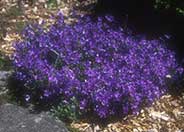
Common name:Dymondia, Rock Ditty
Botanical name:Dymondia margaretae
This foliage is gray/green/silvery; it is a very dense, mat forming ground cover. It tolerates drought, cold, salt spray and poor soils. It's deep rooted and produces small, inconspicuous yellow flowers. Rock Ditty is great for use in between stepping stones or pavers.
Maintenance Tips
Dymondia margaretae is a low, perennial ground cover that forms a very dense mat of silver-green foliage capable of choking out other plants. It stays lower than 2" tall and can spread out to 15". This is a very drought tolerant plant, but it grows much faster and thrives with regular irrigation. The most common maintenance issue with this plant is weeding. It is naturally slow-growing when it is getting established, which allows seeds and other creeping plants to emerge between the plants. Using a pre-emergent can be very effective in keeping weed seeds from germinating, but creeping plants will have to be removed by hand. Regular weeding can keep your Dymondia looking and performing its best. Once the plant has filled in, there is less space for weeds to grow, so the maintenance will decrease over time. Once established, it can creep and grow around the base of other plants. Prune it away from other plants to prevent them from being choked out.
Common name:Dalmation Bellflower
Botanical name:Campanula portenschlagiana
The Dalmation Bellflower is a mounding, deciduous perennial that forms a curtain of purple flowers often blooming in waves throughout the year. It should be grown in areas with sun to partial shade.
Photographer: GardenSoft
Incorporate compost 6" into your soil to retain water, reduce compaction, feed earthworms, and provide valuable nutrients to your plants.
Attract, or buy beneficial insects such as ladybugs and lacewings to control pest outbreaks in your garden.